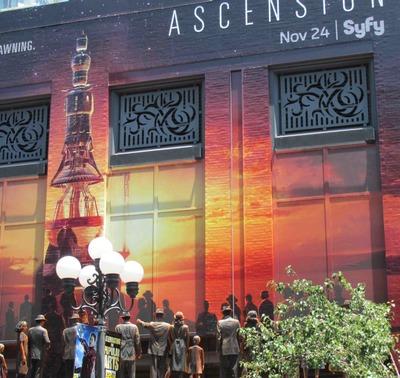Mad Men… in spaceby Dwayne A. Day
|
| The “Mad Men” connection is that the people on Ascension still reflect American society of 1963, without experiencing any of the social or cultural upheaval or transformation in the past five decades. |
And so now we have “Ascension,” a new show debuting on the SyFy Channel in November. The show’s premise is that President Kennedy was so rattled by the near extinction of humanity during the Cuban Missile Crisis that he created a project to send 600 people into space aboard a large spacecraft named Ascension, headed toward the planet Proxima. Now, 50 years later, things are starting to fall apart on the multi-generational spaceship. This insurance policy for humanity is starting to show its strains.
The “Mad Men” connection is that the people on Ascension still reflect American society of 1963, without experiencing the Civil Rights era, feminism, the Vietnam War, Watergate, or any other social or cultural upheaval or transformation in the past five decades. Women still wear dresses and cook for their husbands, men are the leaders, and people still listen to Elvis and Frank Sinatra. But not everything is going smoothly. The crew experiences their first murder, and the social fabric is starting to come apart.
“Ascension” was the topic of a panel at San Diego Comic Con on Saturday. The panel consisted of Tricia Helfer, who plays Viondra Denninger, but is best known to science fiction fans as the Cylon Six, from “Battlestar Galactica” (Six broke an infant’s neck early in that series, so she wasn’t exactly a hero; maybe here Helfer gets to play someone less infanticidal). Brian Van Holt plays Captain William Denninger, Andrea Roth plays ship’s doctor Juliet Bryce, and Al Sapienza plays Councilman Rose. Rose is interested in both the captain’s job and his wife, and you can expect conflict to ensue. Also on hand was executive producer Philip Levens.
 “Ascension” cast members Tricia Helfer and Andrea Roth discuss the upcoming series during a Comic Con panel Saturday. (credit: D. Day) |
Levens explained that the science of the show is based in reality—the spaceship is based upon an Orion spacecraft concept that could actually exist. It was launched into orbit beneath a steady pulse of nuclear explosions, and the radioactive wake it has left behind makes communication with Earth impossible. He also said that they built some large sets in Montreal to depict the interior of their giant spaceship, which is as tall as the Empire State Building. A brief trailer showed the ship. This was not the same trailer that the network released earlier which depicted a Saturn V encased in a giant steel latticework floating through space. The new version looks more like the early 1960s Orion concepts, although it was not spinning to provide artificial gravity, and viewers will probably have to not look too hard for scientific accuracy or they’ll get headaches. As part of the promotion for the show, SyFy painted an image of the ship on the outside of a building in downtown San Diego.
Actors speaking on Comic Con panels can often be intimidated by the large audiences as well as the studio restrictions on what they can say about their show, so it is sometimes difficult to tell if they really are as dull and dim as they seem. Of the four actors on the panel, only Sapienza said anything interesting. In response to a question about what the world might look like fifty years from now, Helfer said she’s a pessimist and figures we’ll all be dead. Roth and Van Holt had forgettable answers. In contrast, Sapienza was more reflective, saying that one real cultural change he has observed during his lifetime—he’s in his fifties—is an understanding that we are responsible for the world we live in. He grew up Catholic, but says that people today are less likely to believe that we can simply expect God to fix our messes. In response to a question about what the actors most remember about the space program, the other three mentioned the Challenger accident, but Sapienza said that he was home sick from school when the Apollo 1 fire happened, and it had a big impression upon him. He also said that during the Apollo 11 landing he took a photograph of his TV screen as Neil Armstrong stepped onto the surface.
| The “Mad Men” connection is that the people on Ascension still reflect American society of 1963, without experiencing any of the social or cultural upheaval or transformation in the past five decades. |
The network showed only a short clip from the show, a grainy black and white documentary that the crew watches once a year. It depicts the ship’s creator announcing the program and revealing the tabletop model of the Ascension. To date, the studio has filmed only the pilot and first episode, and is starting filming on the next episode today.
Is “Ascension” going to be any good? It’s on the SyFy Channel, so chances are probably pretty weak. The connection to 1963 is also somewhat worrying. “Mad Men,” despite its excellent characterizations and depictions of its era, has often taken a rather superior position, looking down upon the socially backward people of the Eisenhower era. They are often shown as homophobic, anti-Semitic, misogynistic, polluting jerks. This somehow implies that we’re all better now. Certainly none of those problems exist today, right?
We’ll have to wait and see. I’ll admit that I never thought that the “Battlestar Galactica” remake would work either, and that turned out pretty well, not simply because of Tricia Helfer.
